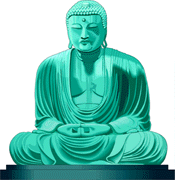
 Zen Buddhism
Zen Buddhism 
When I moved to Japan in 1976, one of my first goals here was to seek out a place to study Zen firsthand. My first teacher was a wizened old monk named Harada, who lectured and led zazen sittings one Sunday each month at Eifukuji Temple in Ebisu, Tokyo. He was quite a character with his Einstein-like wild grey hair, his twinkling eyes, dark blue kimono, white tabi socks, and a right hand permanently paralyzed by arthritis into the perfect position for holding a fude calligraphy brush. Each month, he hand-printed postcards with images of the season to remind us of our sessions. And he taught me how to sit. Just sit. For that is exactly what zazen is: just sitting.
Once I had learned to sit, I sat quite a lot. I sat at home mostly, in the early mornings and late evenings. But there is no experience quite like sitting in the zendo hall, with the temple bell sounding, the candle light reflecting off the shoji rice paper screens, and the priest walking slowly behind as you meditate, ready to whack you with the kiyosaku, should you accidently start to nod off.
I wanted more of this life. And I wanted to experience satori enlightenment, where one becomes fully aware of the nothingness of being. I joined a group that spent one weekend a month at a temple in Saitama Prefecture (north of Tokyo), where we joined in the routines of the local monks. Those were some of the longest most restful weekends of my life. And it was an experience I would later write about for the Okura Lantern magazine. (I'll be adding the text here at a later date).
Gaynor Jenke, the leader of our group, was an Australian woman who later became a deshi apprentice to the Saitama temple. I owe her a lot. I never reached full enlightenment, but I did learn a lot from her and the weekends. On one occasion, I did have a flash of satori too, when a crow called out loudly, just outside the zendo one morning about dawn. Aspects of the zen experience permeate much of my writing, and are explicit in several sections of The Last Book.
One regret I always had during those many sittings was my inability to get my legs into a full lotus position. I sat in the half lotus for years. Then, one evening I was at a little pub named Capri in Shin-Koenji, Tokyo. A Japanese merchant marine was sitting at the bar drinking cold sake rice wine from a water glass filled to the brim. We chatted about his own search for satori, and how he had taken three years to walk the length of Japan, just like the poet Bassho had once done. I mentioned my temple visits, and my problems with the lotus position. He had me sit on the floor at the back of the bar and in just a few minutes taught me how to get into the position correctly by extending one leg first. It was simple. Then again, aren't most things in life simple when you learn how to do them the right way?
My advice to those who wish to learn Zen is to forget the koan riddles, the how-to books, and the esoteric lectures; go straight to doing zazen. Just sitting is not as easy as it sounds. Sitting is not thinking about tomorrow's schedule, or listening to a catchy tune playing in your head, or concentrating on the pain in your back. Sitting is just sitting. And eating is just eating. And walking is just walking. That is the Zen way: Be Here Now. So much more easily said (and studied) than done.
